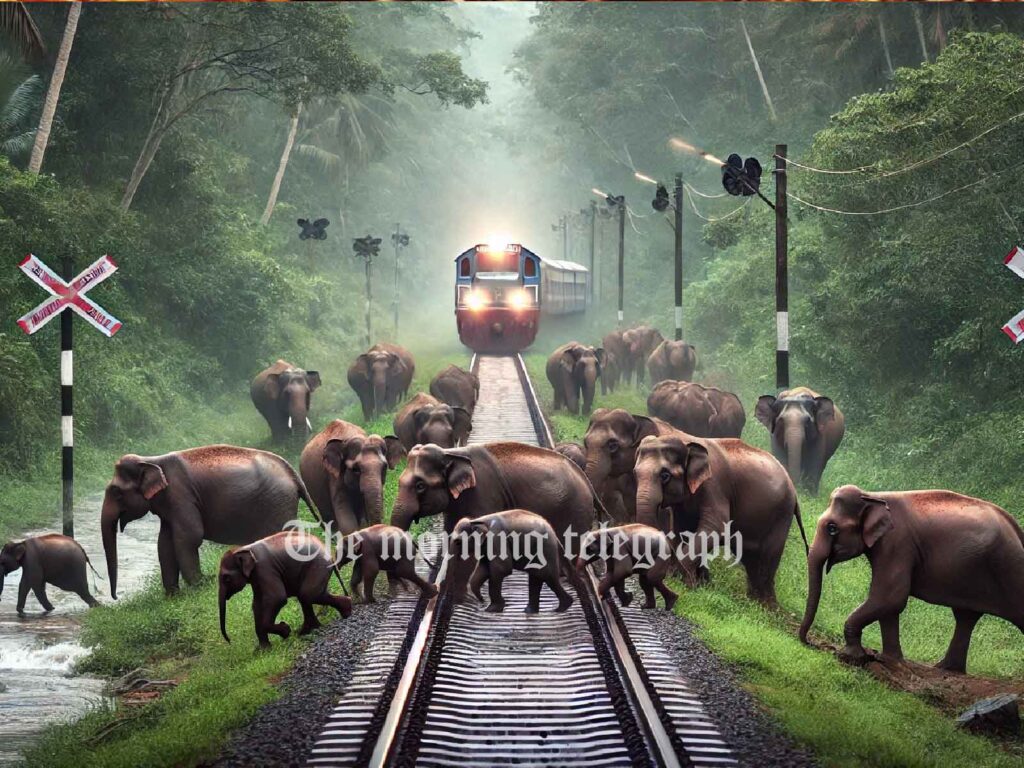
The government has yet to announce a concrete plan to prevent a repeat of the Meenagaya train accident, which resulted in the deaths of six elephants.
The tragic loss of six elephants and several baboons from the forest reserve, a vital wildlife resource that adds to Sri Lanka’s natural beauty, has deeply saddened both locals and foreigners.
The accident occurred on the night of February 19 when a herd of elephants collided with the Meenagaya train traveling from Colombo to Batticaloa. Many people have shared their opinions about the incident on social media.
A BBC Sinhala investigation revealed that, as of February 19, 2025, a total of 65 elephant deaths had been reported in Sri Lanka within the first 50 days of the year. Nine of these deaths were caused by train collisions. This suggests that, on average, more than one elephant has died per day during this period.
According to a statement from the Department of Wildlife Conservation, at around 11:30 pm, seven elephants collided with the Meenagaya train near the 140 km mark between the Minneriya and Galoya railway stations. In the accident, three elephant calves and two adult females died, while another adult female and a calf were injured.
The injured elephants are being treated by a team of Giritale Wildlife Veterinary Officers, according to a statement issued by the Acting Director General of the Department of Wildlife Conservation, M.S.L.R.P. Marasinghe.
Further investigations into the accident are ongoing.
One of the injured elephants has died while receiving treatment, and the condition of the injured calf remains critical, according to Environment Minister Dr. Dhammika Patabendi. He also confirmed that among those who died, one was a male elephant calf, while the rest were female elephants.
A discussion regarding the incident was scheduled to take place in Parliament on Thursday, February 20, involving key stakeholders such as the Railways Department, the Wildlife Conservation Department, environmentalists, and other concerned parties.
Minister Patabendi stated that urgent action would be taken within two to three days following the discussions to determine the necessary measures to prevent such incidents in the future.
The minister also mentioned that previous measures had been taken to prevent elephant-train collisions, but some were abandoned or proved ineffective. He emphasized the need to review past strategies, identifying which measures failed and which were discontinued.
He noted that a program to have wildlife officers accompany trains had been introduced in the past but was eventually discontinued due to various challenges. The minister assured that immediate action would be taken to ensure that elephants do not continue to die in this particular area.
Addressing Parliament on February 6, Environment Minister Patabendi stated that 3,477 elephant deaths had occurred in Sri Lanka over the past decade. He reported that between 2015 and 2019, 1,466 elephant deaths were recorded, while between 2020 and 2024, the number increased to 2,011. This indicates a rise in elephant fatalities in recent years.
According to the Department of Wildlife Conservation, 24 elephants died in train collisions in 2023, while 11 elephants lost their lives in similar accidents in 2024.
Environmentalists have called for both short-term and long-term solutions to prevent such tragedies. Environmentalist Pubudu Weeraratne pointed out that in some areas, trains cannot slow down due to steep terrain, where maintaining speed is necessary for the train to pass through. However, he also highlighted other contributing factors to these accidents.
One issue he raised was the poor condition of train headlights, which limits visibility. He also mentioned that in the past, a wildlife officer would travel on certain trains to monitor elephant movement, but this practice has largely been discontinued. He suggested that the problem must be addressed with both immediate and long-term solutions.
Weeraratne further criticized the lack of sustained attention to the issue, stating that discussions only take place when an elephant accident occurs, but little follow-up action is taken afterward. He argued that one immediate solution could be to deploy night patrols in high-risk areas before trains pass through.
He also suggested constructing overpasses or underpasses for elephants to cross safely, restricting their access to railway tracks, or enforcing speed limits in high-risk zones.
The Railways Department has called for a report on the accident, according to Railways General Manager Dhammika Jayasundara. He acknowledged that the railway line was built along an elephant migration route, making collisions more likely. He also noted that the high embankments on either side of the tracks prevented the elephants from escaping.
BBC Sinhala inquired about the construction of designated elephant crossing points along the upgraded Northern Railway line, and officials confirmed that this work would be completed soon.
Although the train involved in the accident has not yet been removed from the site, railway services have resumed normal operations, according to the Railways General Manager.




